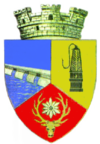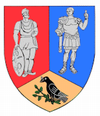- Uricani
-
Uricani — Town — 
Coat of armsLocation of Uricani Coordinates: 45°20′11″N 23°9′9″E / 45.33639°N 23.1525°ECoordinates: 45°20′11″N 23°9′9″E / 45.33639°N 23.1525°E Country  Romania
RomaniaCounty Hunedoara County Status Town Government – Mayor Dănuţ Buhăescu Odagiu (PSD Party) Area – Total 251.41 km2 (97.1 sq mi) Population (2002) – Total 10,307 Time zone EET (UTC+2) – Summer (DST) EEST (UTC+3) Website http://www.uricani.ro/ Uricani (Romanian pronunciation: [uriˈkanʲ]; Hungarian: Urikány) is a town in the Jiu Valley region of Hunedoara County, in southern Transylvania, Romania. As of 2004[update] it had a population of 10,307.
Contents
History
Uricani is first mentioned in a certified document dated 1818, when the locality was referred to as Hobiceni-Uricani, the name it carried until the union of 1918. The name of Uricani is derived from the name Hobiţa (listed in documents from 1411) and Uric (from 1473) from Haţeg Land. After the union of Transylvania with Romania, the locality's name was changed to Uricani. Over time, the village of Câmpu lui Neag functioned as either a separate commune or as a village belonging to Uricani. In 1965, Uricani was declared a city. It administers two villages, Câmpu lui Neag and Valea de Brazi.
Like the other Jiu Valley cities, Uricani's principal economic activities revolve around the region's coal mines, although the city, like the region, is in a period of transition as the mines have been gradually closed and many of the workers made redundant.
Location
The city location lies on the western side of Jiu Valley and at the foot of the Retezat Mountains, with the geographical coordinates of 23o10’ meridian, east longitude and 45o25’ parallel, north latitude. The city is located in Hunedoara County and adjacent to Mehedinti and Gorj counties. It lies at an altitude of 729 m altitude on the west side of the Petrosani Depression and along the West Jiu River. Its area also contains the smaller waterways of Lazarul, Valea de Pesti, Buta, and Bilugu, as well as the fresh water reservoir which contains the drinking water used throughout Jiu Valley.
Uricani is accessed via the DN 66A, the 27 kilometer long west branch of the DN 66 that connects the cities of Petrosani, Vulcan, Lupeni and Uricani.
The city covers 25,141 hectares, the largest geographical area of all the Jiu Valley cities. The city limits are bordered to the east by Cow’s Valley, to the west by Retezat National Park, to the north by peaks of the Retezat Mountains (Custura, Lazarul -2282m, and Tulisa-1782m), and to the south by peaks of the Vâlcan Mountains (Coarnele-1789m and Siglaul Mare-1682m). The surrounding mountains are part of the Meridional Carpathians (in an area commonly referred to as the Transylvanian Alps).
See also
External links
- Jiu Valley Portal - the regional portal host of the official Jiu Valley websites
Hunedoara County, Romania Cities 
Towns Communes Baia de Criş · Balşa · Băniţa · Baru · Băcia · Băiţa · Bătrâna · Beriu · Blăjeni · Boşorod · Brănişca · Bretea Română · Buceş · Bucureşci · Bulzeştii de Sus · Bunila · Burjuc · Cerbăl · Certeju de Sus · Cârjiţi · Crişcior · Densuş · Dobra · General Berthelot · Ghelari · Gurasada · Hărău · Ilia · Lăpugiu de Jos · Lelese · Lunca Cernii de Jos · Luncoiu de Jos · Mărtineşti · Orăştioara de Sus · Pestişu Mic · Pui · Rapoltu Mare · Răchitova · Ribiţa · Râu de Mori · Romos · Sarmizegetusa · Sălaşu de Sus · Sântămăria-Orlea · Şoimuş · Teliucu Inferior · Tomeşti · Topliţa · Toteşti · Turdaş · Vaţa de Jos · Vălişoara · Veţel · Vorţa · Zam
Categories:- Towns in Romania
- Jiu Valley
- Populated places in Hunedoara County
Wikimedia Foundation. 2010.

